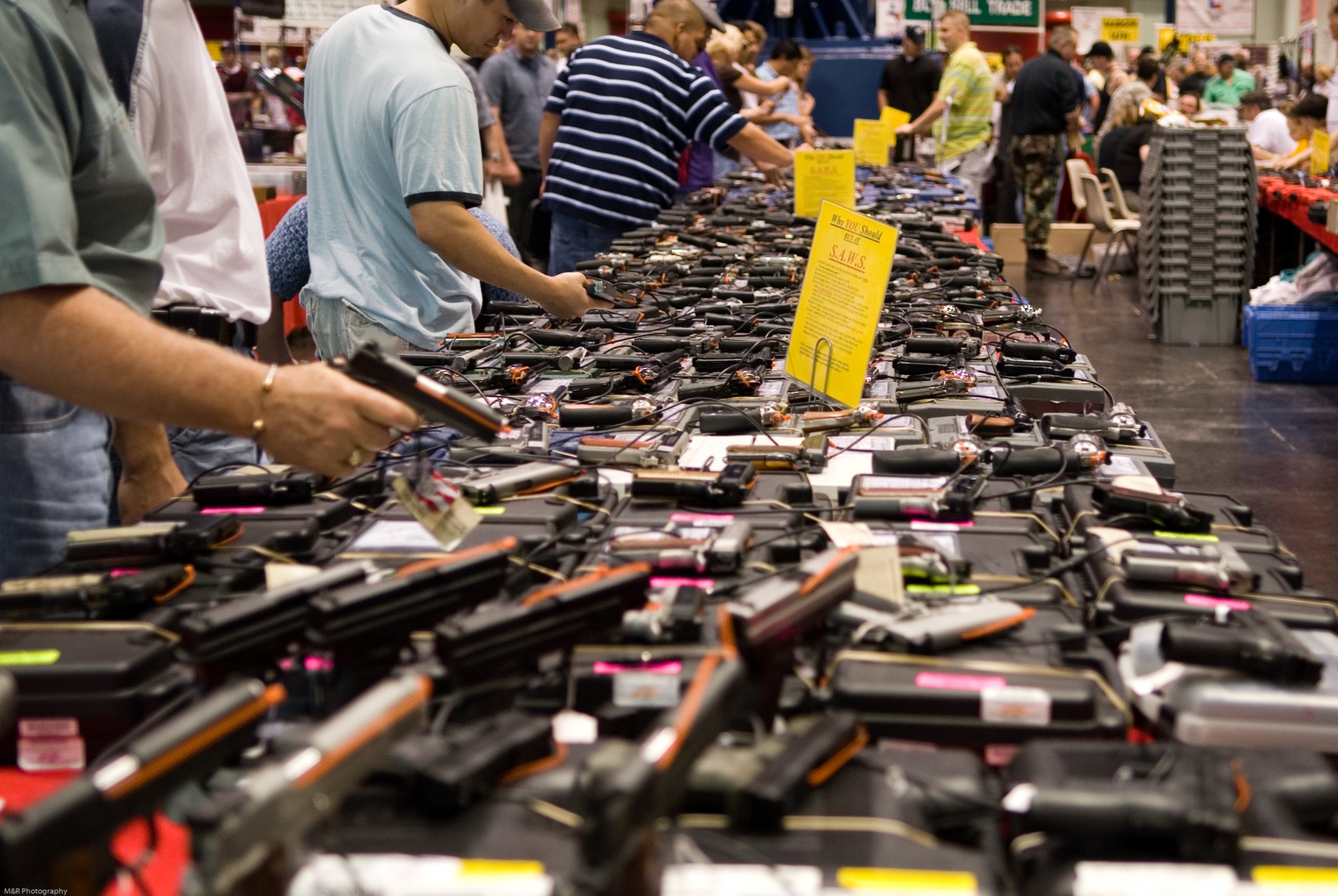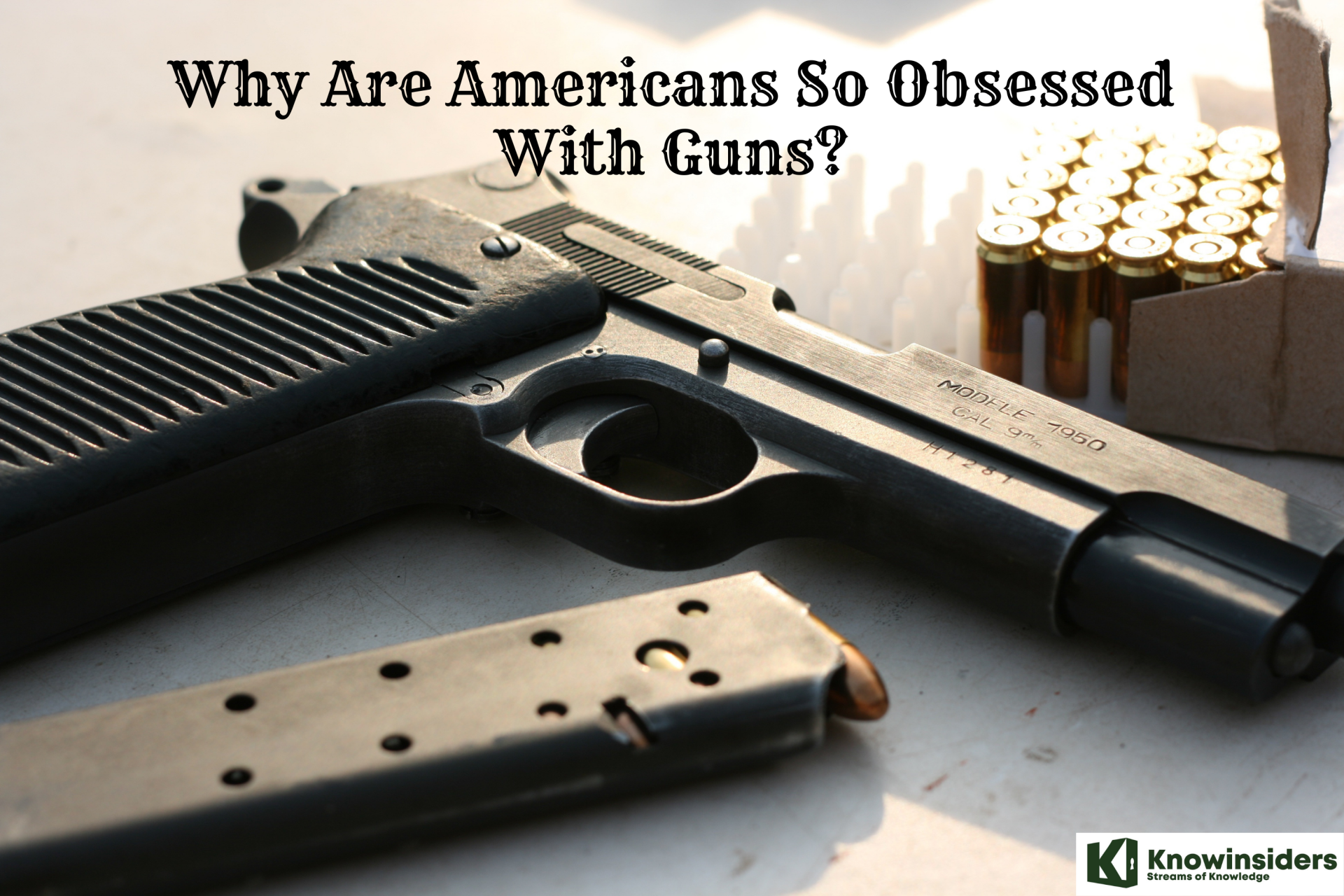Why Are Americans Love and So Obsessed With Guns
|
|
| Why Are Americans So Obsessed With Guns? |
| Table of Content |
The recent series of bloody shootings have made Americans even more obsessed with guns, but most Americans still love guns and want to own them.
America has more guns than any other nation in the world – and that number continues to grow each year. After fighting for their independence, the founding fathers enshrined Americans’ right to firearms in the Second Amendment. This spirit of personal freedom and liberty has carried down through the years and is evident today in America’s gun culture.
Because of this Constitutionally guaranteed right, Americans own more guns per capita than any other country. So, why do Americans love guns, and how many Americans own guns? Let’s take a closer look.
Gun violence - America's "serious disease"
Gun violence is arguably one of the most serious, enduring, and difficult-to-solve problems in America. America is still deeply divided over gun control. This has long been one of the topics that have attracted the attention of voters before every major election, but has never reached the end of a bipartisan compromise, without strong enough laws to prevent it. stop this problem.
According to data from the US Centers for Disease Control and Prevention (CDC), in 2020, the time when the COVID-19 pandemic began to appear and broke out, it led to many impacts on the entire political and economic life. economic and social, an average of 124 people die every day in this country because of guns.
Meanwhile, the US Federal Bureau of Investigation (FBI) said that the number of targeted shootings in the country in 2021 has increased by more than 50% compared to the previous year. Notably, the US has witnessed a record high number of mass shootings with 691 cases in 2021, an average of at least 4 victims. The total number of victims of gun violence in the US last year reached 44,750 people.
According to an online archive that tracks gun violence in the US, the Gun Violence Archive, since 2013, nearly all gun violence metrics for 2021 have set "records."
More than two-thirds of the most populous cities in the US saw more homicides last year than in 2020, significantly like Philadelphia, Pennsylvania, which had the highest number of homicides since 1960; the city of Chicago, Illinois, also recorded 2021 as the most violent year in a quarter of a century; Los Angeles, California, is in its worst state of violence in 15 years.
Notably, hate crimes against Asians increased by 339% in 2021, with Los Angeles and New York being the cities that recorded the most hate crimes of any US city.
Experts point out that social unrest, especially during epidemics, causes millions of Americans to buy guns for the first time.
What is gun culture?
In the United States, gun culture encompasses the behaviors, attitudes, and beliefs about firearms and their usage by civilians. Gun ownership in the United States is the highest globally and is constitutionally protected by the Second Amendment to the United States Constitution. Firearms are widely used in the United States for self-defense, hunting, and recreational uses, such as target shooting.
Gun politics in the United States tend to be polarized between advocates of gun rights, often conservative, and those who support stricter gun control, often liberal. The gun culture of the United States can be considered unique among developed countries in terms of the large number of firearms owned by civilians, generally permissive regulations, and high levels of gun violence.
History of Guns in the U.S.
Soon after the end of the Civil War, gunmakers with surpluses sought peacetime customers. They convinced dry goods stores to sell handguns alongside flour and sugar; they ran classified ads in newspapers, and they told parents that a rifle would help “real boys” to develop “sturdy manliness.” Private gun ownership dramatically expanded.
The end of slavery catalyzed the formation of armed groups, some seeking to protect newly freed Black men, others to terrorize them. After Reconstruction failed, supremacist military groups like the White League in Louisiana used guns to threaten and sometimes murder Black men attempting to vote.
While the popular imagination holds that gunslingers sauntered down the dusty streets of Western towns, that’s largely a myth, according to UCLA law professor Adam Winkler, JD. “Frontier towns—places like Tombstone, Deadwood, and Dodge—actually had the most restrictive gun control laws in the nation,” Winkler wrote in the Huffington Post. When visitors arrived in Dodge City, Kansas, they encountered a billboard announcing, “The Carrying of Firearms Strictly Prohibited.”
Indeed, by the early 1900s, 43 states limited or banned firearms in public places. Gun control would become sharply divisive only with the federal Gun Control Act of 1968, made law after the assassinations of President John F. Kennedy, Malcolm X, Martin Luther King Jr., and Robert F. Kennedy. The legislation limited interstate sales of firearms but did too little to satisfy gun control advocates including President Lyndon Johnson.
By the late 1990s, fear became a potent selling point as cultural attitudes changed. In a 1999 poll, most gun owners said they kept guns for hunting and target shooting; only 26% cited protection as paramount. By 2015, however, 63% cited self-defense as a primary motivation for gun ownership, according to a 2015 National Firearms Survey. In reality, having access to a gun triples a person’s risk of suicide and nearly doubles the risk of being a homicide victim, according to a 2014 Annals of Internal Medicine meta-analysis. For a woman living with an abusive partner, the risk of being murdered increases fivefold if the partner has a gun, according to an American Journal of Public Health study led by Jacquelyn Campbell, PhD, MSN, a faculty member of the Johns Hopkins Center for Gun Violence Prevention and Policy at the Bloomberg School.
As gun owners increasingly emphasized self-defense in recent decades, restrictions on carrying concealed firearms evaporated. Whereas in 1990 concealed carry in public spaces was illegal in 16 states (including Texas), by 2013 all 50 states and Washington, D.C., allowed some civilians to carry hidden guns.
At the same time, gunmakers have redesigned their wares. “Technology has focused on making smaller and smaller handguns, with more lethality, and with almost no attention to safety,” says Josh Horwitz, JD, who directs the Coalition to Stop Gun Violence. For example, the popular $450 Smith & Wesson M&P Shield 2.0 pistol is 6 inches long and carries 15 9mm cartridges. And children now have their own firearms, like the 2½-pound, .22-caliber Crickett (“my first rifle”). Its gunstock comes in pink, camo, and “amendment”—Second Amendment text overlaid on American flags.Horwitz says lobbyists and owners of military-style weapons increasingly embrace “the insurrectionist idea.” Since 2009, he has warned of armed citizens who claim that “threatening violence against government officials is within normal bounds of political discourse.”
The multiplication of “stand-your-ground” laws marked another shift in American attitudes, withFlorida takingthe lead in 2005. Today, 34 states give gun owners the right to use deadly force outside of the home with no duty to retreat or use other means to protect themselves. The laws “make it much easier for a person to legally kill someone,” writes University of Texas sociologist Harel Shapira, PhD, who credits the laws with “the militarization of everyday life.”
“In almost any aspect of public health, culture and policy are reinforcing and reflecting each other,” says Daniel Webster, ScD ’91, MPH, director of the Center for Gun Violence Prevention and Policy. “You gradually see carrying a gun around as normative.” Forty years ago, if someone brought a gun to a party, Webster says, “you would have been shocked. It would have been incredibly abnormal.” Now, gun ownership is a lifestyle choice, one rooted in the individualism “baked into our culture and our laws.”
In recent decades, the National Rifle Association has identified its greatest foe as the government itself. After Congress passed the Federal Assault Weapons Ban of 1994, NRA President Wayne LaPierre told members that the bill “gives jack-booted government thugs more power to take away our constitutional rights, break in our doors, seize our guns, destroy our property, and even injure or kill us.”
“The gun lobby thrives on fear and drives fear,” says Horwitz. In many ways, he adds, “this is about white men feeling less powerful.”
Horwitz notes that gun sales rose during the past year. “People are afraid of other people with guns, so now they’re buying guns. Breaking that cycle is really important. Are we too far down the road? I don’t think we are, but we’ve got to make major changes in how we approach gun violence, soon.”
How Many Guns are there in the US?
 |
| Photo: americangunfacts |
The United States has a lot of guns, especially for a massive, peaceful, and prosperous country. In fact, about 1/3 of all the civilian guns in the world are in the hands of Americans.
32% of Americans say they personally own a firearm according to the 2021 National Firearms Survey. This means that more than 81.4 million Americans own guns. This number only includes adults over 18. When you include family members who live in the same household as a gun owner, that number jumps to 41% of all Americans. Gallup has this figure estimated at 44% of households.
There are estimated to be over 400 million guns in the United States between police, the military, and American civilians. Over 393 Million (Over 98%) of those guns are in civilian hands, the equivalent of 120 firearms per 100 citizens. The average gun-owning American has 5 firearms, while nearly 22% of gun owners only have a single firearm.
The United States is unique among the community of nations in many ways. America’s cultural and historic views and its laws surrounding gun ownership are surprising to many. By way of comparison, the nation that is second place on that list is the tiny British territory of the Falkland Islands with 62 firearms per 100 citizens.
Gun Ownership by State
Highest Gun Owning States
- Montana: 66.3%
- Wyoming: 66.2%
- Alaska: 64.5%
- Idaho: 60.1%
Lowest Gun Owning States
- Massachusetts: 14.7%
- New Jersey: 14.7%
- Rhode Island: 14.8%
- Hawaii: 14.9%
Gun ownership in the US and other countriesThe US also has by far the highest number of privately owned guns in the world. In 2017, the number of civilian-owned firearms in the US was 120.5 guns per 100 residents, meaning there were more firearms than people. The world’s second-ranked country was Yemen, a quasi-failed state torn by civil war, where there were 52.8 guns per 100 residents, according to a 2018 Small Arms Survey. More recent data also suggests that gun ownership grew significantly over the last several years. One study, published by the Annals of Internal Medicine in February, found that 7.5 million US adults - just under 3% of the population - became the first new gun owners between January 2019 and April 2021. |
Why do American Love and Purchase Guns?
Beyond the data on gun ownership in America are the reasons that Americans choose to purchase and maintain firearms.
While the reasons to purchase a firearm vary widely, the most common is self-defense. Over 2/3rds of gun owners list this as the first reason that they personally own a gun.
Hunting, sports shooting, collecting, and required for a job round out the list.
While rural gun owners are more likely to hunt or collect guns as a hobby, urban and suburban gun owners are more likely to list personal protection as their primary concern.
Firstly, their constitution has given them this right. They can possess guns after fulfilling certain conditions.
Secondly, they believe that guns are required for the safety of their lives and property. Law enforcement agencies can’t be present everywhere all the time. Even in case of an emergency, they will take some time to reach. Having a gun with them gives them the self-confidence that they can protect themselves better in an emergency situation.
Thirdly, they believe that gun-related deaths happen because of the negligence of the owners of the gun. As they say- “A gun does not fire, until you fire it”. Hence they don’t believe that guns are responsible, they think owners are responsible.
Most gun owners say they own guns for protection
People own guns for a number of purposes, and most gun owners say they own a gun for more than one reason.
Protection is a motivator for a vast majority of people. A Gallup survey conducted in October 2021 found that 88% of gun owners counted protection against crime as a reason for owning a gun, while 70% counted target shooting and 56% counted hunting as reasons. Similarly, Pew found that two-thirds of gun owners cited protection as a major reason for owning a gun, while about four in 10 cited hunting and three in 10 cited sport shooting as major reasons.
About three-quarters of gun owners see firearms as key to their freedoms, while about half see them as important to their identities, according to Pew.
How do US gun deaths break down?
 |
| Photo: wikipedia |
According to the US Centers for Disease Control and Prevention (CDC), a total of 45,222 people died from gun-related injuries of all causes during 2020, the last year for which complete data is available.
And while mass shootings and gun murders generally garner more media attention, of the total, 54% - about 24,300 deaths - were suicides.
A 2016 study published in the American Journal of Public Health found there was a strong relationship between higher levels of gun ownership in a state and higher firearm suicide rates for both men and women.
Advocates for stricter gun laws in the United States often cite this statistic when pushing lawmakers to devote more resources to mental health and fewer to easing gun restrictions.
Is there REALLY so much gun violence in America?
No other developed country in the world has anywhere near the same rate of gun violence as America. The US has nearly six times the gun homicide rate of Canada, more than seven times the rate of Sweden, and nearly 16 times that of Germany, according to 2012 United Nations data.
More Americans have died from guns just since 1975, including suicides, murders and accidents (more than 1.5 million), than in all the wars in US history, dating back to the Revolutionary War (about 1.4 million). In a typical year, more children from infancy through 4 years old are fatally shot in the United States (about 80) than police officers (about 50 or fewer).
With over 300,000 registered guns and probably another million illegal guns roaming the country, it’s likely at some point you’ll encounter a person carrying a gun. Sure, there are random acts of gun violence, like mass school shootings, but for the most part, day-to-day life is as it is anywhere else in the world.
This is a hard question to always have to explain to Europeans who live in a world where gun violence is almost non-existent and guns are securely locked away and used only for sports/competitions/hunting. They are a gun-loving nation who want and need to protect ourselves from intruders and people who might do harm. Yet, they also complain about the amount of gun violence in our communities.
Firearms became the leading cause of death for US children and adolescents starting in 2020, surpassing motor vehicle accidents, according to a University of Michigan research letter published in the New England Journal of Medicine last month.
Tuesday's school shooting was the deadliest since a gunman killed 26 people, including 20 children, at Sandy Hook Elementary School in Connecticut in December 2012.
Why Are There so Many Mass Shootings in the US?
Who supports gun control?
Only 52% of Americans surveyed said they wanted stricter gun laws, while 35% said they should remain the same.
Eleven percent surveyed said laws should be "made less strict".
The issue is also one that is hyper-partisan and extremely divisive, falling largely along party lines.
"Democrats are nearly unanimous in their support for stricter gun laws," the same Gallup study noted, with nearly 91% in favor of stricter gun laws.
Only 24% of Republicans, on the other hand, agreed with the same statement, along with 45% of Independent voters.
Who opposes gun control?
Despite years of financial woes and internal strife, the National Rifle Association (NRA) remains the most powerful gun lobby in the United States, with a substantial budget to influence members of Congress on gun policy.
In January, the NRA filed for bankruptcy as part of a fraud case against some of its own senior staff. Even after the move, it vowed to continue "confronting anti-Second Amendment activities, promoting firearm safety and training, and advancing public programs across the United States".
Over the last several election cycles, it, and other organizations, have consistently spent more on pro-gun rights messaging than their rivals in the gun control lobby.
How do US gun killings compare with other countries?In 2020, 43% of the deaths - amounting to 19,384 people - were homicides, according to data from the CDC. The figure represents a 34% increase from 2019 and a 75% increase over the course of the previous decade. Nearly 53 people are killed each day by a firearm in the US, according to the data. The data also shows that the vast majority of murders, 79%, were carried out with guns. That's a significantly larger proportion of homicides than is the case in Canada, Australia, England and Wales, and many other countries. |
Conclusion
In many states in the US, owning a gun is even easier than owning a pet dog and that's strange.
After the Covid pandemic, many days of frustration, anger and hatred used guns to kill a specific group. The reason for the recent increase in mass shootings has also been linked to factors such as gun license requirements and gun rights laws in some states allowing people the right to carry handguns outside. homes without a permit or with a state-issued permit.
The "serious disease" called gun violence has also become a challenge, dominating American politics. Perhaps the United States must fill the gulf of divisions over gun control if it is to ensure the safety of all citizens.
| Loosening gun control regulations have led to the practice in places like Texas where people 21 years of age and older can carry a firearm without a license or training - while two certifications are required to practice barbershop this. People 18 years of age and older can buy a gun if they come from a violent family (the argument is to protect themselves from an abusive relative). Buying a gun was the first thing Ramos did when he was 18, and he shot his grandmother before shooting at school. |
 Full List of Top 50 Best Places to Live in America Right Now Full List of Top 50 Best Places to Live in America Right Now Explore the best places to live in in the U.S. based on crime, public schools, cost of living, job opportunities, and local amenities. |
 Rich People in America: Must Have Assets of $2.2 Million Rich People in America: Must Have Assets of $2.2 Million How Much Money Does It Take to be Considered Rich in America? An annual survey asks Americans to do just that, and this year, $2.2 ... |
 Top 10 Least Popular States That You Don't Want to Visit in USA Top 10 Least Popular States That You Don't Want to Visit in USA Let’s take a look at the 10 Least-Visited States in America and which states made the not-so-popular list below! |
























